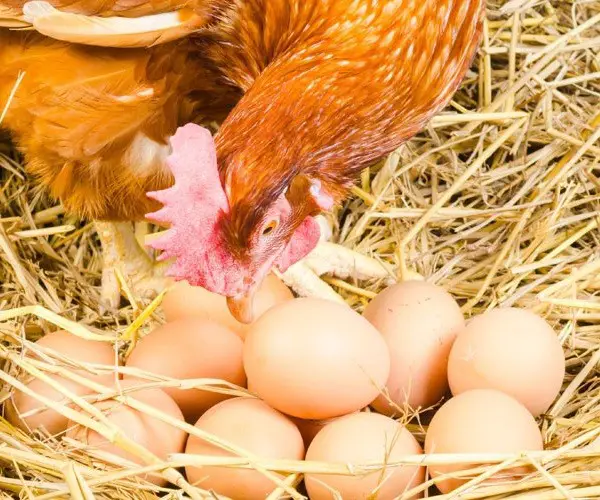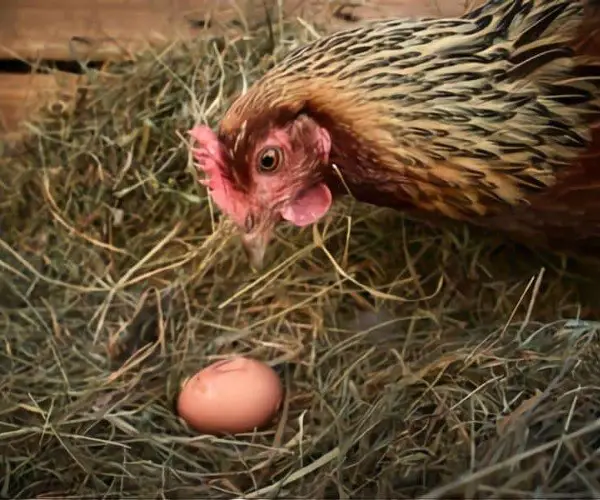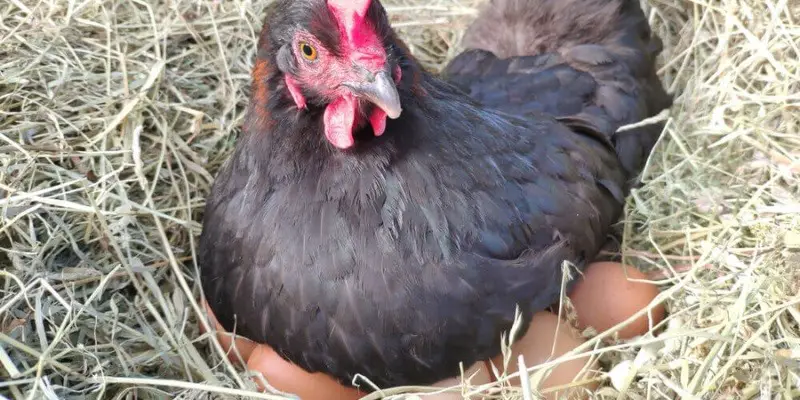Last Updated on January 14, 2025 by Pauline G. Carter
When a hen goes broody, she stops laying eggs and instead focuses all her energy on hatching a clutch of eggs. But how many eggs can a broody hen sit on? It turns out, it depends on the size of the hen.
Smaller hens can typically sit on 8-12 eggs, while larger hens can sit on up to 20 eggs. However, the ideal number of eggs for a broody hen to hatch is between 10-14. If a broody hen is sitting on too many eggs, she won’t be able to keep them all warm and they won’t hatch.
So, if you have a broody hen who is sitting on a clutch of eggs, make sure she’s not sitting on too many. The ideal number of eggs for her to hatch is between 10-14.
How Many Eggs Can A Broody Hen Sit On? This is a common question that many people have when they are first getting into chicken keeping. The answer, like with most things in life, is it depends.
There are a few factors that will affect how many eggs a broody hen can sit on. The first is the size of the hen. A larger hen will be able to cover more eggs and keep them warm better than a smaller hen.
The second factor is the number of times the hen has gone broody. A hen that has gone broody more often will be better at it than a hen that is going broody for the first time. The third factor is the temperature.
If it is cold outside, the hen will need to be able to cover more eggs to keep them warm. Generally, a broody hen can sit on anywhere from 3-21 eggs. If you have a hen that is on the smaller side or it is her first time going broody, you might want to start with a smaller number of eggs.
If you have a larger hen or it is a warm day, she might be able to handle more eggs. The best way to find out how many eggs your hen can sit on is to just let her go broody and see how many she can comfortably cover. You can always add more eggs if she seems to be doing well with the number she has.
How long can a hen stay off her eggs before they die?
When it comes to how long a hen can stay off her eggs, there is no definitive answer. It depends on a number of factors, including the temperature of the environment and the age of the eggs. Generally speaking, however, if the eggs are left unincubated for too long, they will eventually die.
The best way to ensure that your eggs remain viable is to keep them in an incubator, where they will be kept at a consistent temperature and humidity level. If you must leave them for an extended period of time, be sure to check on them regularly to make sure they are not over- or under- incubating.
How do i know if my hen is sitting on fertilized eggs?

If you’re wondering whether or not your hen’s eggs are fertilized, there are a few tell-tale signs you can look for. First, check to see if the eggs are being incubated. Hens will typically sit on their eggs for about 21 days to incubate them.
If you find your hen is sitting on her eggs for this length of time, it’s a good indication that they are fertilized. Another way to tell if your hen’s eggs are fertilized is to candling them. This is a process where you hold an egg up to a bright light to see inside of it.
You can typically tell if an egg is fertilized if you see a dark spot inside of it. This dark spot is the embryo. If you’re still not sure whether or not your hen’s eggs are fertilized, you can always ask your veterinarian for help.
They can perform a test called an egg biopsy to determine if the eggs are fertilized.
How long does it take to hatch a chicken egg without an incubator?
Chickens are amazing creatures. Not only do they provide us with delicious eggs, but they also help keep our yards and gardens free of pests. And, as any farmer will tell you, chickens are also very efficient at converting food into meat.
But how long does it take to hatch a chicken egg without an incubator? It turns out that the answer to this question is somewhat complicated. chicken eggs can take anywhere from 18 to 21 days to hatch, depending on the temperature and humidity of the environment in which they are incubated.
If the temperature is too low, the eggs will not develop properly and will not hatch. If the temperature is too high, the embryos will develop too quickly and will not have time to form a proper shell. The ideal temperature for incubating chicken eggs is between 99 and 102 degrees Fahrenheit.
The humidity of the incubation environment is also important. If the humidity is too low, the egg will lose too much moisture and will not hatch. If the humidity is too high, the egg will absorb too much moisture and will also not hatch.
The ideal humidity for incubating chicken eggs is between 55 and 60%. So, what does all of this mean for someone who wants to hatch a chicken egg without an incubator? Well, it is possible to do so, but it takes a bit of work.
First, you need to find a location that has the correct temperature and humidity.
Can you eat eggs that a chicken has been sitting on

If you found an egg that a chicken has been sitting on, you may be wondering if it’s safe to eat. The answer is yes, you can eat eggs that a chicken has been sitting on, but there are a few things to keep in mind. First of all, the egg may be contaminated with bacteria from the chicken’s bottom, so it’s important to clean the egg before eating it.
You can do this by washing it with soap and water, or you can sanitize it with a vinegar solution. Secondly, the egg may not be as fresh as one that was laid in a clean nest. If you’re concerned about the freshness of the egg, you can check the expiration date on the egg carton.
Overall, there’s no need to worry if you find an egg that a chicken has been sitting on. Just make sure to clean it well and check the expiration date before eating it.
Can you add eggs to a broody hen
If you have a broody hen, you may be wondering if you can add eggs to her nest. The answer is yes, you can! Adding eggs to a broody hen’s nest is a great way to increase your flock’s egg production.
Here’s how to do it: 1. Gather your eggs. Make sure they are clean and free of cracks.
2. Place the eggs in the nest, being careful not to disturb the broody hen too much. 3. The broody hen will likely rearrange the eggs to her liking. Once she is done, she will settle back down on the eggs and begin incubating them.
4. That’s it! The broody hen will take care of the rest. In 21 days, you’ll have baby chicks!
Can you put more eggs under a broody hen?
Broody hens are hens that have gone through a hormonal change that allows them to sit on a nest of eggs in order to incubate them. This is a natural process that hens go through in order to reproduce. Can you put more eggs under a broody hen?
The answer is yes, you can put more eggs under a broody hen. In fact, many people choose to do this in order to increase the chances of the eggs being fertilized and hatching. There are a few things to keep in mind when adding more eggs to a broody hen’s nest.
First, make sure that the eggs are clean and free of any dirt or debris. This will help the hen to keep the nest clean and increase the chances of the eggs being incubated successfully. Second, make sure that the eggs are of similar size.
This will help the hen to turn the eggs more easily and prevent them from rolling out of the nest. Third, do not add too many eggs at once. It is best to slowly add eggs to the nest over the course of a few days so that the hen can get used to them.
Adding more eggs to a broody hen’s nest can be a great way to increase the chances of fertilization and hatching. Just be sure to keep the above tips in mind in order to give the eggs the best chance of success.
How many eggs will a hen lay before she sits on them?
A hen will typically lay one egg per day, although this can vary slightly based on the breed of chicken. Once a hen has laid a clutch of eggs (usually around 12), she will then sit on them to incubate them. The length of time it takes for a hen to hatch her eggs will also vary based on the breed, but is usually around 21 days.
How long will a broody hen sit on infertile eggs?
When a hen is broody, she will sit on her eggs until they hatch. If the eggs are infertile, she will eventually give up and stop sitting on them. It can take up to 21 days for a hen to give up on her eggs.
Can 2 hens sitting on same eggs?
Sure, two hens can sit on the same eggs. In fact, it’s pretty common for hens to share a nest. But there’s a catch: the eggs need to be fertile for this to work.
If the eggs are infertile, then it doesn’t really matter how many hens are sitting on them. The eggs won’t hatch no matter what. But if the eggs are fertile, then two hens sitting on them can actually help to incubate them.
The hens will take turns sitting on the eggs, and the warmth from their bodies will help to keep the eggs at a consistent temperature. This can improve the chances of the eggs successfully hatching. Of course, there’s no guarantee that two hens sitting on the same eggs will actually result in baby chicks.
But it’s definitely worth a try if you’re hoping to increase your chances of success.
Can 15 Eggs be laid under a Broody Hen :: Watch Her Preparation For It
Conclusion
A broody hen is a chicken that has the instinct to sit on a clutch of eggs to incubate them. This is a common behavior in many chicken breeds and is usually triggered by the lengthening of the days (more daylight = more eggs being laid). While a broody hen is certainly capable of sitting on a large number of eggs, there are a few things to consider if you’re thinking about letting her incubate a large clutch.
First, a broody hen will not eat or drink much while she’s sitting on eggs, so she’ll need to be well-nourished before she starts her sitting stint. Second, a large number of eggs will produce a lot of heat, so the broody hen will need to be in a well-ventilated area to avoid overheating. Overall, it’s best to give a broody hen a smaller number of eggs to sit on (5-7 is a good number), unless you have a specific reason for wanting her to incubate a larger clutch.

